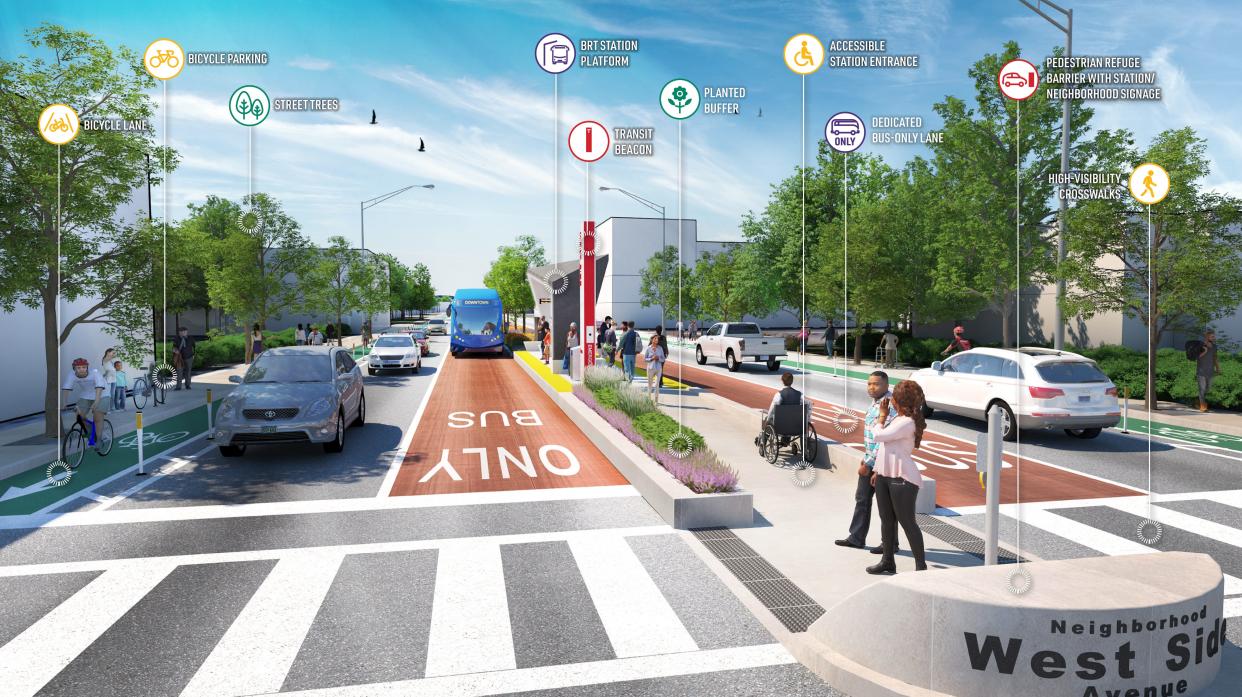LinkUS offers virtual look at proposed bus rapid transit corridor on West Broad Street
Columbus' first virtual bus stops are here.
On a media tour Thursday, LinkUS — a bus rapid transit (BRT) initiative planned by the Central Ohio Transit Authority and other government agencies — showed off their new augmented reality (AR) stops along the planned West Broad Street Corridor.
These AR stops allow smartphone users to overlay virtual renderings of LinkUS planned infrastructure improvements — which include dedicated rapid bus lanes, protected bike lanes, central and side bus stops, sidewalks and more — over the real world using their device's camera.
"If you are a visual learner, like I am, (the AR is) really giving you those visuals of what the street could look like. All of these renderings are to give folks an idea," Columbus City Councilmember Lourdes Barroso de Padilla said Thursday.
LinkUS is an $8-billion initiative by the Central Ohio Transit Authority, the Mid-Ohio Regional Planning Commission, the city of Columbus and the Franklin County Commissioners to build bus rapid transit corridors to serve the region with the goals of providing better, more efficient mass transit service; to provide that service along routes where Columbus is expected to allow denser zoning with more multi-family residences nearby to help handle projected future growth in Columbus; reduce vehicular traffic on those routes and provide more bike lanes and sidewalks.
Bus rapid transit is like "a subway above ground", according to Aslyne Rodriguez, COTA's senior director of regional partnerships. Under the LinkUS plan, 60-foot-long accordion buses wide enough to accommodate bikes and motorized wheelchairs will run along each corridor in mixed traffic along dedicated bus lanes.

The buses will pick up passengers on the side of the roads in mixed traffic and at central bus stations in areas with dedicated bus lanes. The rapid transit buses will have traffic light priority, meaning they can get through intersections faster, Rodriguez said.
The West Broad Street corridor is the first of three corridors planned for LinkUS in Columbus. It's currently in the design phase and is expected to open in late 2027 or early 2028, according to LinkUS's website.
But these infrastructure improvements can't happen unless voters in Franklin County and parts of some neighboring central Ohio counties approve an additional 0.5% sales tax for COTA this fall, Rodriguez said. If approved, COTA's sales tax would total 1%, and the funds would be used to provide the local funding share to leverage federal dollars for the LinkUS plan.
One of the benefits of the new AR stops is that they provide residents—and potential voters—an idea of what their tax dollars could pay for, Barroso de Padilla said.
"I think for us it was really important to make this an investment and have folks come and experience it so they can begin to start to use their imagination about what this really could be and how they're going to experience it," she said.
How do you take the AR tour?
Residents can download the inCitu AR app and travel to the three bus stops on West Broad Street at Westland Mall, South Westgate Avenue and Belle Street to get a look at what LinkUS could look like.
Once there, residents can scan QR codes found on sidewalk decals to launch the app, according to a LinkUS news release.
@NathanRHart
This article originally appeared on The Columbus Dispatch: LinkUS offers virtual look at West Broad bus rapid transit corridor
